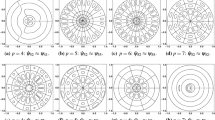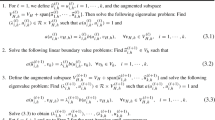Abstract
A posteriori error estimators based on auxiliary subspace techniques for second order elliptic problems in \(\mathbb {R}^d\ (d\ge 2)\) are considered. In this approach, the solution of a global problem is utilized as the error estimator. As the continuity and coercivity of the problem trivially leads to an efficiency bound, the main focus of this paper is to derive an analogous effectivity bound and to determine the computational complexity of the auxiliary approximation problem. With a carefully chosen auxiliary subspace, we prove that the error is bounded above by the error estimate up to oscillation terms. In addition, we show that the stiffness matrix of the auxiliary problem is spectrally equivalent to its diagonal. Several numerical experiments are presented verifying the theoretical results.


















Similar content being viewed by others
References
Adjerid, S., Aiffa, M., Flaherty, J.E.: Hierarchical finite element bases for triangular and tetrahedral elements. Comput. Methods Appl. Mech. Eng. 190(22–23), 2925–2941 (2001)
Ainsworth, M., Oden, J.T.: A posteriori error estimation in finite element analysis. In: Pure and Applied Mathematics. Wiley, New York (2000)
Araya, R., Poza, A.H., Stephan, E.P.: A hierarchical a posteriori error estimate for an advection–diffusion–reaction problem. Math. Models Methods Appl. Sci. 15(7), 1119–1139 (2005)
Arnold, D.N.: Spaces of finite element differential forms. In: Brezzi, F., Colli-Franzone, P., Gianazza, U.P., Gilardi, G. (eds.) Analysis and Numerics of Partial Differential Equations, volume 4 of Springer INdAM Series, pp. 117–140. Springer, Milan (2013)
Bank, R.E.: Hierarchical bases and the finite element method. In Acta numerica, 1996, volume 5 of Acta numerica, pp. 1–43. Cambridge University Press, Cambridge (1996)
Bank, R.E., Grubišić, L., Ovall, J.S.: A framework for robust eigenvalue and eigenvector error estimation and Ritz value convergence enhancement. Appl. Numer. Math. 66, 1–29 (2013)
Bank, R.E., Nguyen, H.: \(hp\) adaptive finite elements based on derivative recovery and superconvergence. Comput. Vis. Sci. 14(6), 287–299 (2011)
Bank, R.E., Smith, R.K.: A posteriori error estimates based on hierarchical bases. SIAM J. Numer. Anal. 30(4), 921–935 (1993)
Bank, R.E., Xu, J., Zheng, B.: Superconvergent derivative recovery for Lagrange triangular elements of degree \(p\) on unstructured grids. SIAM J. Numer. Anal. 45(5), 2032–2046 (2007) (electronic)
Bernardi, C., Verfürth, R.: Adaptive finite element methods for elliptic equations with non-smooth coefficients. Numer. Math. 85(4), 579–608 (2000)
Beuchler, S., Schöberl, J.: New shape functions for triangular \(p\)-FEM using integrated Jacobi polynomials. Numer. Math. 103(3), 339–366 (2006)
Bornemann, F.A., Erdmann, B., Kornhuber, R.: A posteriori error estimates for elliptic problems in two and three space dimensions. SIAM J. Numer. Anal. 33(3), 1188–1204 (1996)
Braess, D., Pillwein, V., Schöberl, J.: Equilibrated residual error estimates are p-robust. Comput. Methods Appl. Mech. Eng. 198(1314):1189–1197 (2009). HOFEM07 International Workshop on High-Order Finite Element Methods (2007)
Cai, Z., Wang, Y.: Pseudostress-velocity formulation for incompressible Navier–Stokes equations. Int. J. Numer. Methods Fluids 63, 341–356 (2010)
Carnevali, P., Morris, R.B., Tsuji, Y., Taylor, G.: New basis functions and computational procedures for p-version finite element analysis. Int. J. Numer. Methods Eng. 36(22), 3759–3779 (1993)
Craig, A.W., Zhu, J.Z., Zienkiewicz, O.C.: A posteriori error estimation, adaptive mesh refinement and multigrid methods using hierarchical finite element bases. In: The Mathematics of Finite Elements and Applications. V (Uxbridge, 1984), pp. 587–594. Academic Press, London (1985)
Deuflhard, P., Leinen, P., Yserentant, H.: Concepts of an adaptive hierarchical finite element code. IMPACT Comput. Sci. Eng. 1(1), 3–35 (1989)
Dörfler, W., Nochetto, R.H.: Small data oscillation implies the saturation assumption. Numer. Math. 91(1), 1–12 (2002)
Eijkhout, V., Vassilevski, P.: The role of the strengthened Cauchy–Buniakowskiĭ–Schwarz inequality in multilevel methods. SIAM Rev. 33(3), 405–419 (1991)
Ern, A., Guermond, J.-L.: Theory and Practice of Finite Elements, volume 159 of Applied Mathematical Sciences. Springer, New York (2004)
Ern, A., Vohralík, M.: Polynomial-degree-robust a posteriori estimates in a unified setting for conforming, nonconforming, discontinuous Galerkin, and mixed discretizations. SIAM J. Numer. Anal. 53(2), 1058–1081 (2015)
Holst, M., Ovall, J.S., Szypowski, R.: An efficient, reliable and robust error estimator for elliptic problems in \(R^3\). Appl. Numer. Math. 61(5), 675–695 (2011)
Huang, W., Kamenski, L., Lang, J.: A new anisotropic mesh adaptation method based upon hierarchical a posteriori error estimates. J. Comput. Phys. 229(6), 2179–2198 (2010)
Kamenski, L.: A study on using hierarchical basis error estimates in anisotropic mesh adaptation for the finite element method. Eng. Comput. 28(4), 451–460 (2012)
Kreuzer, C., Siebert, K.G.: Decay rates of adaptive finite elements with Dörfler marking. Numer. Math. 117(2), 679–716 (2011)
Li, H., Ovall, J.: A posteriori error estimation of hierarchical type for the Schrödinger operator with inverse square potential. Numer. Math. 128(4), 707–740 (2014)
Melenk, J.M., Wohlmuth, B.I.: On residual-based a posteriori error estimation in \(hp\)-FEM. Adv. Comput. Math. 15(1–4), 311–331 (2002). 2001. A posteriori error estimation and adaptive computational methods
Ovall, J.S.: Function, gradient, and Hessian recovery using quadratic edge-bump functions. SIAM J. Numer. Anal. 45(3), 1064–1080 (2007) (electronic)
Papastavrou, A., Verfürth, R.: A posteriori error estimators for stationary convection–diffusion problems: a computational comparison. Comput. Methods Appl. Mech. Eng. 189, 449–462 (2000)
Petzoldt, M.: A posteriori error estimators for elliptic equations with discontinuous coefficients. Adv. Comput. Math. 16(1), 47–75 (2002)
Schwab, C.: \(p\)- and \(hp\)-finite element methods. Numerical Mathematics and Scientific Computation. The Clarendon Press, Oxford University Press, New York (1998). Theory and applications in solid and fluid mechanics
Scott, L.R., Zhang, S.: Finite element interpolation of nonsmooth functions satisfying boundary conditions. Math. Comput. 54(190), 483–493 (1990)
Skalický, T., Roos, H.-G.: Anisotropic mesh refinement for problems with internal and boundary layers. Int. J. Numer. Methods Eng. 46, 1933–1953 (1999)
Szabó, B., Babuška, I.: Finite Element Analysis. Wiley, New York (1991)
Verfürth, R.: A Review of a Posteriori Error Estimation and Adaptive Mesh-Refinement Techniques. Wiley, New York (1996)
Verfürth, R.: A posteriori error estimators for convection–diffusion equations. Numer. Math. 80(4), 641–663 (1998)
Verfürth, R.: Robust a posteriori error estimates for stationary convection–diffusion equations. SIAM J. Numer. Anal. 43(4), 1766–1782 (2005). (electronic)
Verfürth, R.: A posteriori error estimation techniques for finite element methods. In: Numerical Mathematics and Scientific Computation. Oxford University Press, Oxford (2013)
Zienkiewicz, O.C., Kelly, D.W., Gago, J., Babuška, I.: Hierarchical finite element approaches, error estimates and adaptive refinement. In: The Mathematics of Finite Elements and Applications IV (Uxbridge, 1981), pp. 313–346. Academic Press, London (1982)
Acknowledgements
This work was supported in part by the National Science Foundation through Grants DMS-1417980 (Neilan) and DMS-1414365 (Ovall).
Author information
Authors and Affiliations
Corresponding author
Rights and permissions
About this article
Cite this article
Hakula, H., Neilan, M. & Ovall, J.S. A Posteriori Estimates Using Auxiliary Subspace Techniques. J Sci Comput 72, 97–127 (2017). https://doi.org/10.1007/s10915-016-0352-0
Received:
Revised:
Accepted:
Published:
Issue Date:
DOI: https://doi.org/10.1007/s10915-016-0352-0




